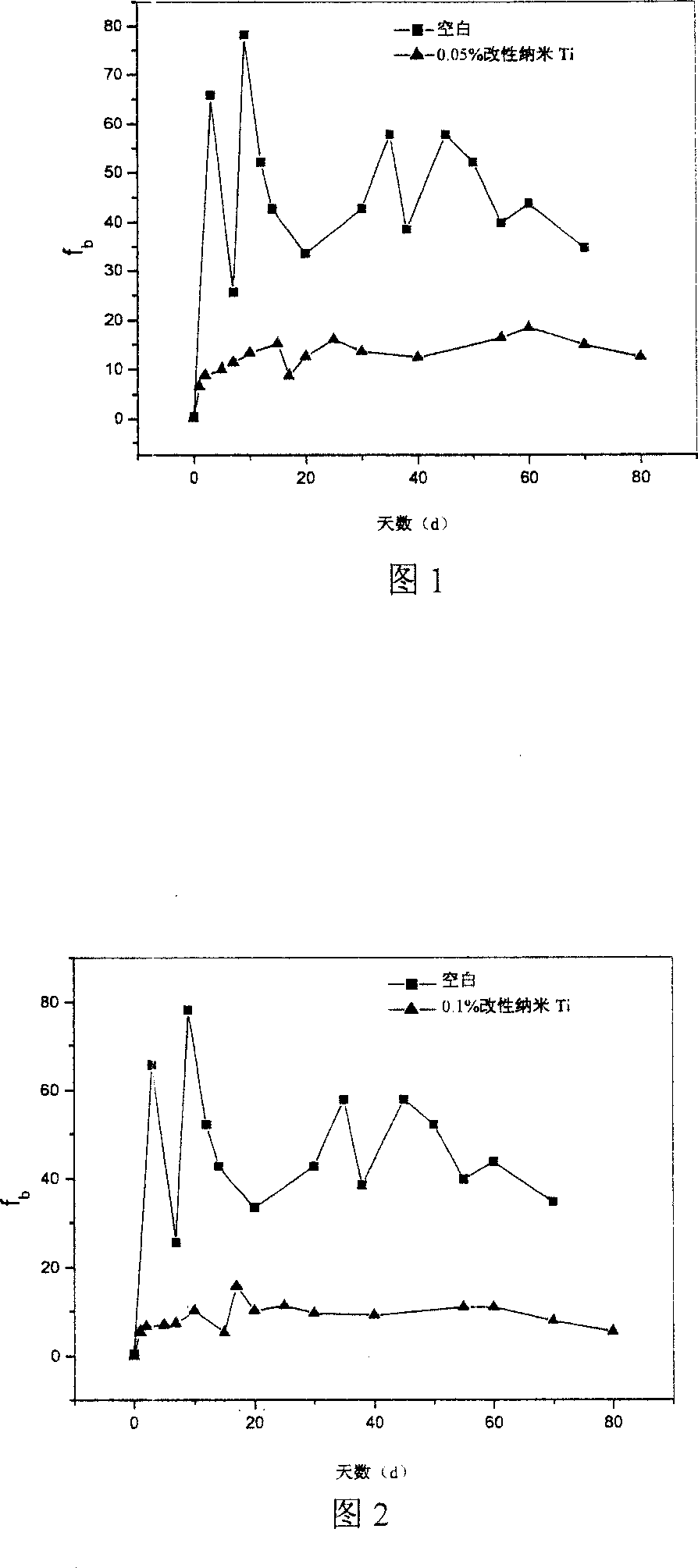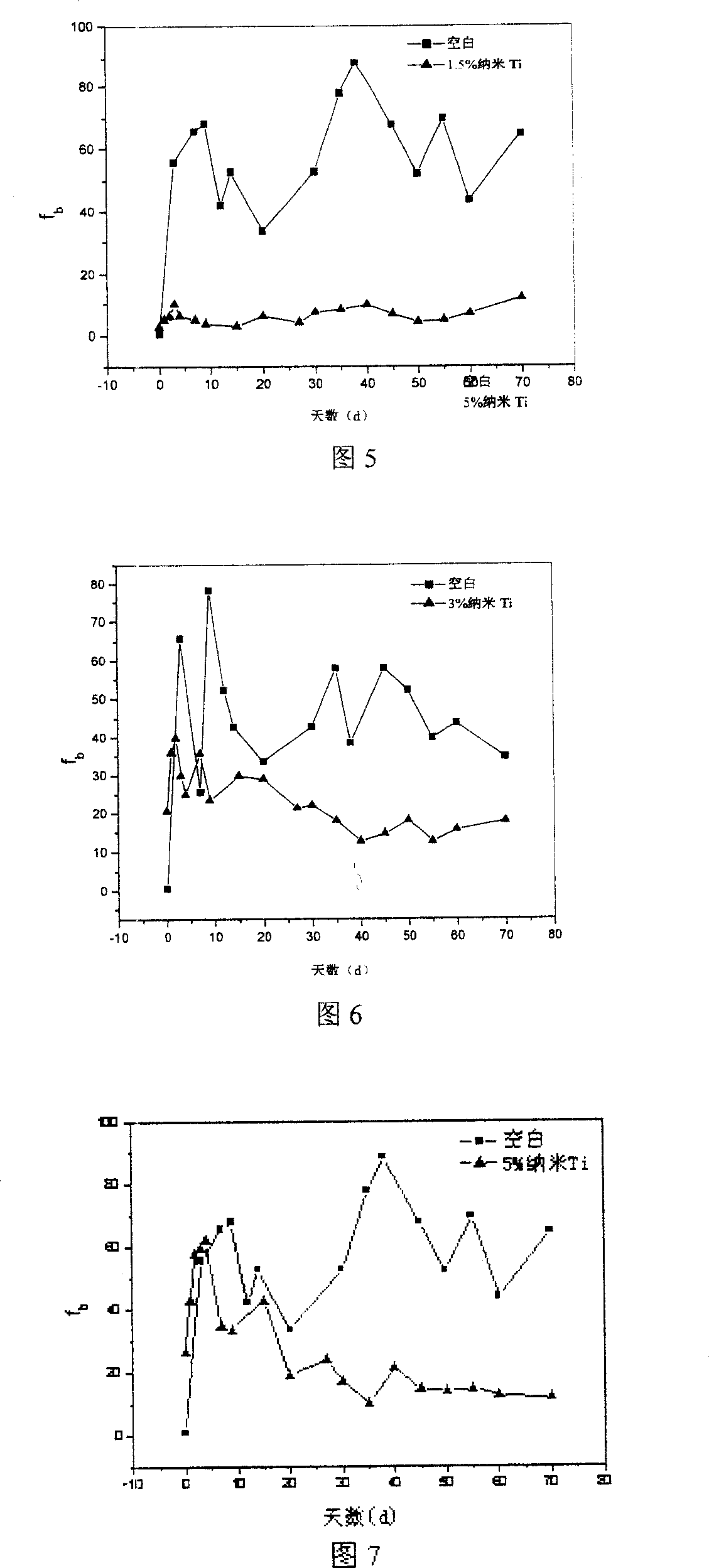Organic protective paint having low adding quantity of nano titanium particle and its preparation method
A technology of protective coatings and additions, applied in epoxy resin coatings, coatings, etc., to achieve the effect of low industrial application cost and low additions
- Summary
- Abstract
- Description
- Claims
- Application Information
AI Technical Summary
Problems solved by technology
Method used
Image
Examples
Embodiment 1
[0037] Coating Formulation:
[0038] Modified nano-Ti particles: 0.05% (particle size 20-80nm);
[0039] Dispersant: 0.5%;
[0040] Dibutyl phthalate: 5%;
[0041] Xylene: n-butanol=7: 3 20%;
[0042] Epoxy resin (using E-44): balance.
[0043] Among them: nano-Ti particle composition and modification method:
[0044] Ingredients (percentage by weight):
[0045] Al 2 (SO 4 ) 3 Solution (10%) 5%;
[0046] NaOH solution (10%) 5%;
[0047] Nano Ti particles 70%;
[0048] Deionized water 20%.
[0049] The preparation of the modified nanoparticles is to introduce hydroxyl groups (through Al 2 (SO 4 ) 3 react with NaOH); specific operation: put nano-Ti particles into a round-bottomed flask, slowly pour deionized water into it, stir, and at the same time raise the temperature to 60 °C, put the Al 2 (SO 4 ) 3 The solution and the NaOH solution were added dropwise at the same time, and the dropping rate was controlled at 30 drops / min; after the dropwise addition was co...
Embodiment 2
[0061] Difference with embodiment 1 is coating formula:
[0062] Modified nano-Ti particles: 0.1% (particle size 20-80nm);
[0063] Dispersant: 1%;
[0064] Dibutyl phthalate: 5%;
[0065] Xylene: n-butanol=7: 3 5%;
[0066] Epoxy resin (using 6458): balance.
[0067] Wherein: Nano Ti particle modification composition (by weight percentage):
[0068] Al 2 (SO 4 ) 3 Solution (10%) 20%;
[0069] NaOH solution (10%) 20%;
[0070] Nano Ti particles 50%;
[0071] Deionized water 10%.
[0072] The difference in the preparation of the modified nanoparticles is: put the nano-Ti particles into a round bottom flask, slowly pour deionized water into it, stir, and at the same time raise the temperature to 65°C, and put the Al 2 (SO 4 ) 3 The solution and the NaOH solution were added dropwise at the same time, and the dropping rate was controlled at 25 drops / min; after the dropwise addition was completed, the temperature was kept and continued to stir for 3 hours; after the re...
Embodiment 3
[0079] Embodiment 3 (by weight percentage)
[0080] Difference with embodiment 1 is coating formula:
[0081] Nano-Ti particles: 0.5% (particle size 55-100nm);
[0082] Dispersant: 1%;
[0083] Dibutyl phthalate: 5%;
[0084] Benzene: n-butanol=6:4 20%;
[0085] Epoxy (E-42): balance.
[0086] Wherein dispersant composition (by weight percentage):
[0087] Potassium dodecylbenzenesulfonate 50%;
[0088] Disperbyk-161 45%;
[0089] Benzene 5%.
[0090] Accurately weigh the prepared paint mother liquor, add polyamide curing agent in a ratio of 10:6, and after aging for 1 hour, smear and cure. Conduct coating protection performance test (see Figure 3).
[0091] It can be seen from Figure 3 that the characteristic frequency of the coating with 0.5% nano-Ti particles has been kept in a small range, indicating that the protective performance of the coating is better than that of the coating without nano-Ti particles.
PUM
| Property | Measurement | Unit |
|---|---|---|
| particle diameter | aaaaa | aaaaa |
| particle diameter | aaaaa | aaaaa |
Abstract
Description
Claims
Application Information
 Login to View More
Login to View More - R&D
- Intellectual Property
- Life Sciences
- Materials
- Tech Scout
- Unparalleled Data Quality
- Higher Quality Content
- 60% Fewer Hallucinations
Browse by: Latest US Patents, China's latest patents, Technical Efficacy Thesaurus, Application Domain, Technology Topic, Popular Technical Reports.
© 2025 PatSnap. All rights reserved.Legal|Privacy policy|Modern Slavery Act Transparency Statement|Sitemap|About US| Contact US: help@patsnap.com



